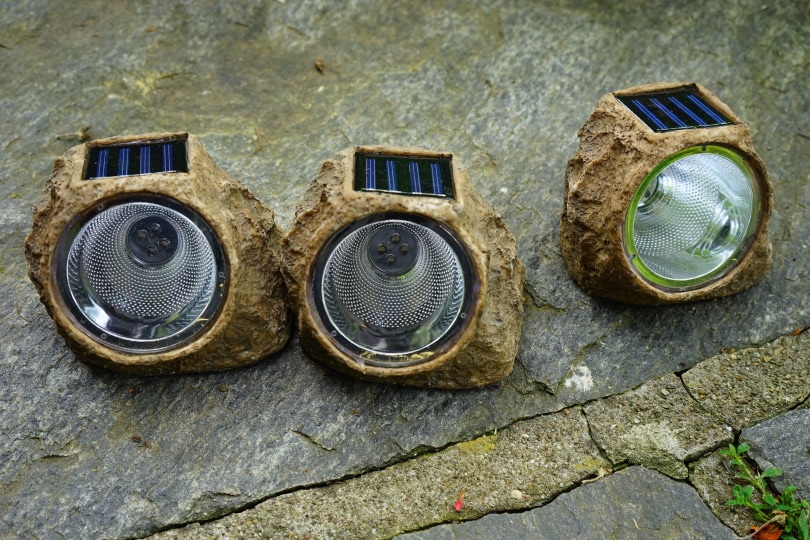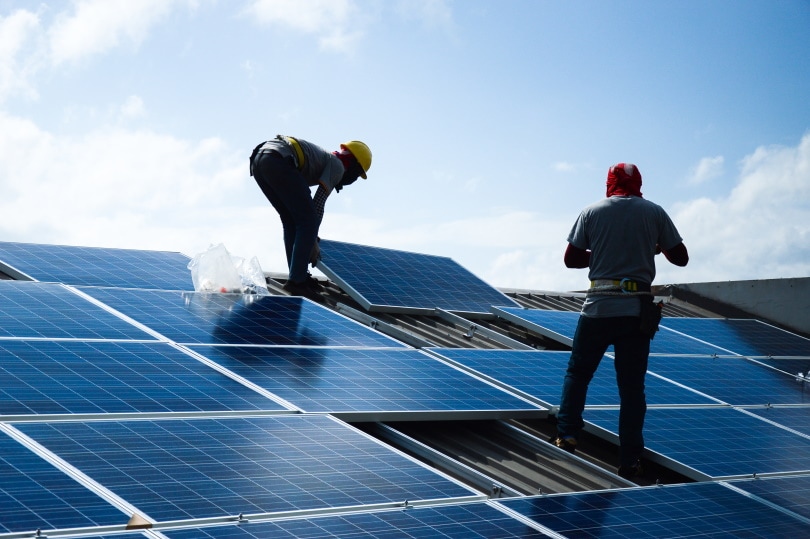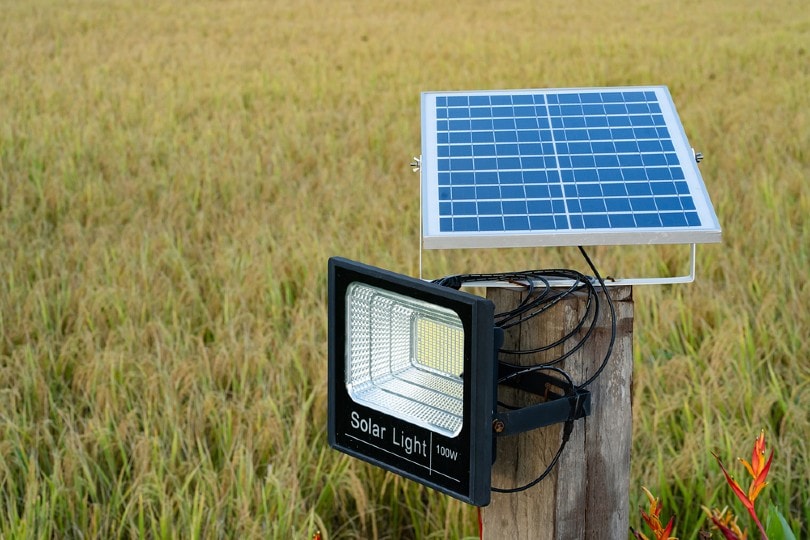How Do Solar Lights Work? Methods, Factors, & FAQ
-
Pete Ortiz
- Last updated:

Have you ever wondered how solar lights work? How do they convert the sun’s energy into electricity and light the way at night? We’ll get into the nitty-gritty of how solar lights work in this article.
Solar lights are an excellent alternative to traditional bulbs. You can find them in many places such as gardens, roads, flag poles, desktops, and many more. They are powered by energy harnessed from the sun’s rays.
This article looks into the details of how solar lights work. Also, we’ll look at why many people are making the switch from traditional electric lights to the eco-friendlier option of solar lights, as well as provide some suggestions for choosing solar lights.
Keep reading to learn more!
How Do They Work?
Solar lights work by capturing the sun’s energy in photovoltaic cells made from silicon layers. A silicon solar cell converts the energy from the sunlight into electricity using the photovoltaic effect.
When sunlight strikes the solar cell, electrons in the silicon are energized and can move freely. The movement of these electrons into an external circuit creates electricity.
Solar cells are connected to form a solar panel. Some of the steps involved during this process include:
The 3 Ways Solar Lights Work
1. Sunlight Hits the Solar Panel
During the day, sunlight shines on the solar panel. The solar panel has a photovoltaic cell that converts sunlight into electricity. Then, it’s stored in a rechargeable battery.
In some cases, the solar panel may be big enough to absorb all the energy it needs to power itself throughout the evening.
Also, there’s a backup battery when there’s no direct sunlight on a cloudy day. So, the photovoltaic cell won’t collect enough energy to power itself through the night.

2. Electricity Flows from the Solar Panel to the Rechargeable Battery
The electricity produced by the solar panels flows into a rechargeable battery inside the solar light. This battery stores the energy.
This way, you can use it even when no sunlight is available. Batteries used in solar lights are made of nickel-metal hydride, cadmium, or lithium-ion.

3. The Photoresistor Detects Darkness
The photoresistor detects the darkness of the night and triggers the battery to send power to the LED bulb. This process happens automatically, as long as the battery has enough power. This way, the LED bulb turns on.
The solar panel charges the batteries during daylight hours. If the solar panel isn’t exposed to enough sunlight for at least eight hours each day, these lights will not function well.

What are the Different Types of Solar Lights?
There’s more than one type of solar light on the market. Below is a list of the different types of solar lights.
Traffic Solar Lights
Traffic lights are a necessity in most towns. Many cities are trying to reduce their carbon footprints and cut costs by switching to alternative energy sources.
A major part of these lights is powered by solar energy. It’s collected during the day through photovoltaic panels and stored in batteries for use at night. Solar traffic lights are life savers in areas that experience frequent power outages.
They need less maintenance than traditional traffic signals. Also, they don’t need wires or cables running underground or overhead.

Street and Parking Lights
Usually, these solar lights are used by municipalities to illuminate roads, parking lots, bike paths, and more. Most solar lights remain stationary, but street and parking lights are mounted onto poles that allow the fixture to rotate throughout the day.
This way, the solar panel can capture as much energy from the sun as possible. When darkness falls, the light will turn on automatically and shine brightly down on the road. It’s inexpensive and also reduces installation costs.
Solar Floodlights
Solar floodlights are used to illuminate large areas. Besides, you can also use them for security purposes. These lights use a photovoltaic cell that converts sunlight into electricity. Then, it’s stored in a battery until needed.
They are often used for outdoor lighting needs because they provide enough illumination. So, you can see what’s going on around even if there isn’t any other light source such as street lamps or house lights nearby.
Solar Garden Lights
One of the most popular types of outdoor lighting is solar garden lighting. Decorative outdoor lighting can bring your yard alive at night while illuminating paths and walkways.
These come in a wide range of styles, colors, and finishes. This way, they can complement any architecture or landscape design.

Solar Desk Lamps
Are you looking for a way to add extra illumination to your home office without worrying about electricity bills? If yes, solar desk lamps might be just what you need. They are an excellent addition to any home office.
They can illuminate your workspace without adding extra heat. The best part is that they don’t need wiring. Just plug them in, charge them up in the sun, and you are good to go!
Solar desk lamps are also affordable. It makes them perfect for students or anyone who needs enough light to write but doesn’t want to spend too much money on a lamp.
Solar Candles
Solar candles are an excellent way to add a little romance and ambiance to any outdoor space. They look like regular candles, but they’re powered by solar energy.
You can use them in place of real candles when decorating for an event. Also, you can place them around the garden for subtle illumination.
Solar Sign Lights
Solar sign lights are an excellent choice when adding light to billboards and other large signs. These lights provide enough light to ensure that the billboard is visible at all-time whether day or night.
They also last a long time because they are powered by the sun instead of batteries or electricity. These lights come in different styles and colors. So, you can match them with your sign or billboard.
What are Solar Lights Made of?
Solar lights are an excellent alternative to traditional outdoor lighting. They can also be a green energy choice and save you money since they’re powered by sunlight. But what are they made of?
Well, here are several components of a solar light.
Photovoltaic Cells
Solar lights use photovoltaic cells to convert the sun’s rays into electricity. These cells make up the solar panel. When the sun hits those cells, it excites the electrons inside them, creating a flow of electricity. This flow creates the energy to power your lights.
Solar lights don’t need a lot of energy. So, they can store this energy in batteries during daylight hours and use it at night.
Diode
A diode is a semiconductor that allows current to flow through in one direction only. Also, it prevents any reverse flow. It’s a valve that prevents your battery from discharging when there’s no sunlight to charge it. Simply put, diodes are placed between the solar panel and the battery to prevent reverse current.
A Rechargeable Battery
A rechargeable battery stores the energy your solar panel has generated over time to use later. It uses chemical energy to create an electrical charge, which powers your solar light at night.

A Photoresistor
It detects the presence of light and varies the resistance depending on the level of light received. It’s often used as a sensor for lighting control applications such as streetlights and parking garage lights.
LEDs (Light Emitting Diodes)
It’s a tiny material that conducts electricity in some situations but not others. When exposed to electric current, it emits light in a specific color. In solar lights, LEDs are used as the primary light source.
The color of the light depends on the type of semiconductor material used in the LED. It may be any color from visible red to ultraviolet. Solar lights often use white LEDs. They emit a combination of colors that appear white to the human eye.
Light Sensors (Not a Requirement)
Besides the photoresistor, several solar lights have extra light sensors, such as:
- PIR (Passive Infra-Red): The change in infrared radiation that triggers the PIR sensor can be caused by any heat source. It’s not only people and animals. If you want to get technical, anything that emits energy will give off some heat waves. So, anything that moves will set off a solar light!
- Lux Sensor: The lux sensor measures how bright light is. You can use it to set a specific brightness level for your solar light’s automatic on/off cycle. For example, you may be using a solar floodlight to illuminate your backyard. It’ll turn on automatically when there’s only one lux of ambient light left or when brightness drops below 20%.

- They are environmentally friendly: Solar lights don’t give off carbon dioxide emissions and other harmful chemicals that can harm the environment.
- They’re cost-effective: Regular electric lights need you to spend money each month on electricity. But solar lights are powered by the sun, which means they’re free to use once you’ve bought them.
- Solar energy is inexhaustible: Since solar energy comes from the sun, it can never be exhausted as long as the sun is shining on our planet. We will always use its power without fear that it’ll run out one day like fossil fuels.
- They need little or no maintenance: These lights last up to five years before needing replacement. You can enjoy years’ worth of savings without worrying about replacement or maintenance.
- No cable-laying work: When you use solar lights, you won’t have to deal with the hassle of laying cables. Solar lights are an excellent way to deal with the challenges of wiring your backyard with lights.
- The initial cost is high: Solar lights purchase and installment cost is high. It’s a one-time investment, but it’s always a concern when adding new solar equipment to your home. It can deter some homeowners who want to keep their costs low.
- The brightness of solar lights varies: The brightness and quality of light produced by solar lamps vary. The solar light’s brightness depends on how much sunlight it absorbed during the day.

Most solar lights will only produce a dim light on cloudy days or in winter when there are fewer daylight hours.
Factors to Consider when Buying Solar Lights
Solar lights have many environmental benefits. Most people are switching to solar-powered lights. So, it’s crucial to know these key factors when making a purchase.
- Quality: Quality is one of the top factors to consider. A high-quality solar light will last longer than a cheap one. Some people usually opt for cheap solar lights but find themselves shopping for new ones after a few months. That’s why it’s necessary to research and buy high-quality solar lights.
- Cost: The cost of solar lights has been dropping over the years, especially since they have become popular with more people using them. But this doesn’t mean that you should buy any cheap one that you come across. Compare the price of different manufacturers before settling for one. You can ask for quotes from manufacturers. Then, choose one that offers quality products at a low price.
- Brightness: The purpose of solar light is to provide illumination at night. It should be bright enough to allow you to move around without tripping over objects due to darkness. When buying solar light, make sure it’s bright enough for your needs. The best way to do this is by reading reviews about the product from previous buyers.
- The Battery’s Durability: The battery of solar light is a crucial part of the system. Having a good battery can mean more light, a brighter shine, and more time for use. When looking for a solar light, look at how long the battery will hold its charge. Usually, it’ll be listed in hours on the box or online description. The longer, the better!
How to Make your Solar Lights Brighter
Clean the Solar Panels
Dirt and dust can block the sunlight from reaching the solar panel, reducing the brightness of your lighting fixture at night. It’s a good idea to clean the solar panel often, especially if you live in a dusty area. Cleaning is easy; use a damp cloth to wipe off any dirt and debris gently.

Inspect the Batteries
Check the batteries if your solar lights still seem dim even after making sure they are fully charged. You may need to replace one or more batteries.
Examine the batteries before replacing them. Sometimes you may need to clean the battery area of your solar light. Corrosion on the battery terminals can affect how well your light charges and stays lit at night.
Inspect Sunlight Exposure
Look at the position of your solar lights, especially if they aren’t getting as bright as they used to be. Check for obstructions such as overhanging tree branches that could be causing shade on the solar panel during the day.
Sometimes, there’s no way to avoid shadows but you can still make sure that your solar lights are receiving enough sunlight by checking how long they’re exposed each day.
If it’s less than six hours, consider moving them somewhere else. You can also cut down tree branches that might be blocking the sunlight.

Removing Plastic Diffusers
Another way to increase the brightness of your solar lights is by removing their plastic diffusers. Usually, these parts are coated with a dark tint on one side. It’s designed to direct light toward the ground.
This part doesn’t need to be there for you to use your solar lights for their intended purpose. So, it’s okay for you to remove it and let more sunlight reach your solar panel and charge your battery faster.
Frequently Asked Questions
1. How long can solar lights function without sunlight?
Many solar lights can go up to four days with no sun if the batteries are charged. The brighter the light, the shorter life the batteries have.
It’s crucial to note that if the lights are switched on for long periods, they will use more battery power. The amount of sunlight absorbed by the solar panels daily determines how long the lights will last.

2. How does a solar street light know when to switch on and off?
Solar lights use a light-sensitive sensor to detect the difference between daylight and darkness. During the day, the sensor doesn’t pick up any light, so the solar light stays off.
Once it gets dark, the sensor detects the lack of sunlight, which triggers the LED light to turn on. It happens automatically.
3. How long do solar lights take to charge?
Solar lights take six hours to charge, depending on whether they are exposed to direct sunlight. If they are not getting direct sunlight, they may take a long time.
Make sure that the solar panel is facing the right direction. That way, it can absorb as much sunlight as possible.

Conclusion
Solar lights can help you avoid the hassle of electricity bills by powering your home. These lights are easy to use and maintain. So, they are ideal for people with limited maintenance skills.
It even gets better! Solar lights do not contribute to greenhouse gas emissions. Also, they don’t cause global warming or other environmental calamities. It’s time to start reducing your carbon footprint today!
Hopefully, you now have a better understanding of how solar lights work. If you plan on buying solar lights, choose a suitable one for your needs. After all, different lights are designed for different situations. You’ll get the most out of your solar-powered lights by choosing a suitable one.
See also:
- A silicon solar cell converts the energy from the sunlight into electricity using the photovoltaic effect.
- The photoresistor detects the darkness of the night and triggers the battery to send power to the LED bulb.
- Solar flood lights are used to illuminate large areas.
- A diode is a semiconductor that allows current to flow through in one direction only.
- The lux sensor measures how bright light is.
- A high-quality solar light will last longer than a cheap one.
- How to make your solar lights brighter
Featured Image Credit: velirina, Shutterstock
Contents


